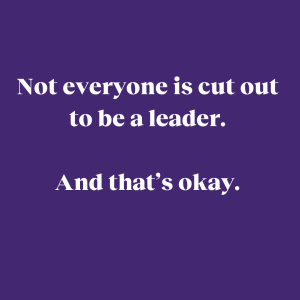We think so…
We’d like to offer a fresh and challenging perspective on the hot topic of improving employees’ wellbeing, mental wellness and workload. Controversially, in a world where leaders are being constantly sold must have services, apps and interventions in this space, our view is that in the main, a “do less” strategy will give greater benefit than launching yet more initiatives.
Achieve less by doing more?
Employers are doing lots more these days to try and improve the well-being and mental health of their employees – we are cheering them on all the way, for the intent at least. However, we wonder if they aren’t addressing these issues from the “wrong end” and in a way that is “bolt-on” and not built-in. We’ll try and explain:
“Wrong end” refers to strategies focused more on the treatment of symptoms as opposed to prevention. E.g. providing a free counselling service or encouraging meditation practice whilst at the same time over-pressurising and micro-managing people. Or offering resilience training; helping people cope with the stress and uncertainty of the latest top-down change programme where they will have to reapply for their jobs. Or running financial wellbeing awareness training whilst not offering a living wage or wage increases that keep up with inflation.
“Bolt-on” by this we mean the universal layering-on of more stuff that employees are expected to engage with, regardless of whether they like the idea or not. Having free fruit in the office, a laughter station, subsidised gym memberships, or having an app that bombards you with questions, tips and reminders will be great for some of us, but for others it can be impersonal, sometimes seen as tokenistic and by some, even disingenuous.
What is the evidence that the “do more strategy” works?
The providers of bolt-on interventions parade all sorts of seemingly compelling evidence about the human and financial benefits of adopting their services. At the same time, an independent review of all the academic research to date finds that there is little strong evidence that bolt-on initiatives make a significant or enduring difference. The headline finding is that “There is some evidence that workplace interventions can improve mental health and wellbeing outcomes, though the size of the effect is often small. Negative effects of interventions are observed in some instances.”
What do we know about the effectiveness of workplace mental health interventions? Kings College London. https://www.kcl.ac.uk/policy-institute/assets/what-do-we-know-about-the-effectiveness-of-workplace-mental-health-interventions.pdf
Funnily enough, not too many instances of burnout are attributed to a lack of fresh fruit or insufficient desk yoga sessions
What are the causes of poor wellbeing that work creates?
Thankfully, much more is known about the causes of poor mental wellbeing at work than about the effectiveness, or otherwise, of the interventions intended to improve it. Interestingly, none of the causes identified are a lack of the things that the “bolt-on” interventions provide. They are, perhaps unsurprisingly, consistent with the causes of employee disengagement[1] and inversely correlated with the accepted conditions for high levels of intrinsic motivation[2].
[1] https://news.gallup.com/businessjournal/182792/managers-account-variance-employee-engagement.aspx
[2] https://www.danpink.com/2010/06/whiteboard-magic/
Achieve more by doing less?
Doing less managing that is. Or less command and control managing to be more specific. By significantly reducing or removing the top-down imposition of programmes, initiatives, targets, coercions, superheroes, quotas, deadlines, reporting requirements, rules, ways of working, etc. and allowing more freedoms and autonomy you will be acting directly on the common causes of poor wellbeing and deteriorating mental health of your people. An additional happy consequence is it leads to the release of time, both for those making the demands and those following them. This, in turn invites the question of what to do instead?
Many of us experience being “overwhelmed”; simply too much to do and not enough time.
A direct benefit of the “do less” strategy is that it results in a lightening of the “bureaucratic load” imposed on people…
Devote the freed-up time to develop more human-centred approaches.
What we are suggesting here is not an initiative, it is better management “built-in” as opposed to accessories “bolted-on”. It is not more work, it is different work, or perhaps “work different”. Current research and our own observations point towards the following as good preventative practices:
- Actively working to create a climate of ever-higher levels of psychological safety[1]. That includes people feeling comfortable saying no.
- Humble leadership[2]. Power distorts relationships, therefore, leaders need to actively work on building open, equal and equitable relationships that put people first.
- Autonomy and decentralised decision authority – Allowing more freedoms and enabling people to make more of the decisions closer to the action
- Greater transparency. This is more than just relaxing the access to files and folders on the company’s servers. It is about leaders and those with influence talking candidly about failures and their own hopes and fears.
- Create awesome jobs – End-to end jobs where people have the opportunity to see things through to the point where they have an impact.
- Encourage experimentation. Creating an environment where there is space and time for “safe to try” experiments and where it’s okay to fail and learn.
But where to start and how? Getting real change happening in each and every team in just some of these areas can feel daunting. Added to which many of us have been conditioned to default to a programmatic approach to change, which is exactly what we don’t want to do.
There is another way. The Vitality Index (VI) identifies for each team in the organisation the three areas of practice that if changed will have the greatest benefit. Our external and impartial facilitation creates a safe space for the teams to explore the insights and commit to change. The Organisational Vitality Playbook inspires and encourages them to come-up with changes that they are truly bought into.
What results is ever-better practices and management with the ingredients for your employees to experience better mental wellbeing “built-in”. How about that for a strategy?
[1] https://bmjopen.bmj.com/content/11/6/e044133
[2] Humble Leadership: the power of relationships, openness and trust. 2018 Edgar Schein, Peter Schein
This is a co-authored post.
Mark Williams is Mark is a successful FTSE 250 HR Director turned consultant and VitalOrg Associate.
Ben Simpson is a Co-founder of VitalOrg and leads on client operations in the UK.




